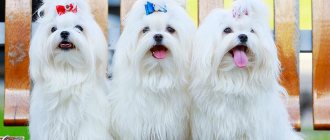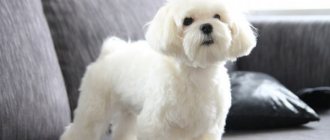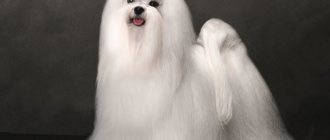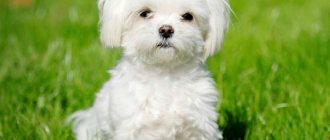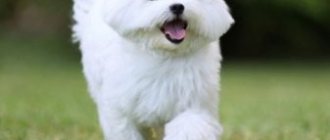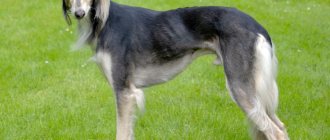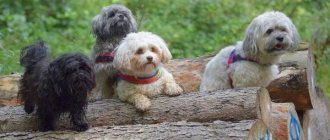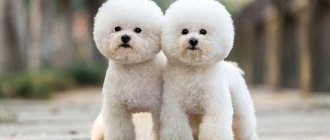Maltese dogs are miniature lap dogs with expressive, curious dark eyes, a slightly elongated body and long snow-white hair. Smart and observant little ones adapt well to the rhythm of life of their owners, but with excessive connivance they easily turn into spoiled and jealous creatures.
Let's find out what Maltese dogs are and how to make life together comfortable for both owners and their pets.
Description of the Maltese breed
Popularity 64th place among 263 dog breeds
Lifespan:
12-14 years old
Breed group:
Decorative
Height:
males: 21-25 cm, females: 20-23 cm
Country of origin:
Italy
Average price:
25-35 thousand rubles
Weight:
3-4 kg
Latest articles Cat health
Rabies vaccination for cats: choice of vaccine, necessity, schedule 01/22/2022 4 0 0
Selection and adaptation
TOP 20 best cat breeds for families with children 01/22/2022 25 0 0
Key facts
The name of the breed Maltese can be replaced by another name - Maltese. It is believed that representatives of this breed cannot have abbreviated names, but the owners do their best to make their pet stand out from other dogs. Fluffy clouds respond best to short, sonorous calls.
The Maltese's country of origin is Italy, and this may explain the temperament of these dogs. Sociability, a sharp mind, a desire to get a dose of attention - all these characteristics of the Maltese breed have made them the center of attention of the whole world.
Females and males are equally reluctant to train.
Pets often participate in the therapy of people suffering from depression due to their friendliness, peacefulness, sensitivity of character, and ability to adapt to the owner’s mood. The animal does not like loneliness, so it is not recommended to leave the fluffy cloud for a long time.
Despite their loud voice, which is often used for other purposes, the Maltese is completely unsuitable for the role of a guard. The only thing they will be capable of if they meet a robber is to wag their tail touchingly or ask them to pet themselves. The description of the Maltese breed clearly states that it will not make a guard dog.
The Maltese's small size makes them ideal city dwellers. The height (height at the withers) of an adult is 21-25 cm for males, 20-23 cm for females; average weight – 3-4 kg.
The lifespan of Maltese dogs is long: dogs live from 12 to 15 years.
The price of a Maltese dog starts from 25,000 rubles. Keeping a pet cannot be called expensive: the main expense items will be the purchase of high-quality food, cosmetics for the coat, visiting a groomer, and paying for exhibitions (if you want to breed puppies).
Application
From the first day of its existence until today, Maltese dogs are exclusively companions. They were created to love and be loved.
At the same time, the Maltese breed demonstrates good watchdog and security qualities. Despite its tiny size, in case of danger the dog fiercely defends itself and its owner. True, not all pets have this trait.
It is worth considering that a small Maltese dog will not cope with protection. She can only bark or claw at an ill-wisher.
Moreover, pets sound the alarm for any reason. An unpleasant-smelling man passed nearby, the doorbell rang, they were shouting behind the wall, someone was climbing the stairs - and the Maltese immediately gave a voice. The dog should be weaned from excessive barking, otherwise complaints and complaints from neighbors will flow in a torrent.
A decorative dog is best suited for housewives, married couples, elderly people and all those who can and are willing to devote almost all their time to their pets.
History of the origin of the Maltese dog
Snow-white fluffies are long-time neighbors of humans, although the place and time of their origin remains a mystery. Scientists have identified three possible hypotheses. One claims that it is impossible to trace the origins of this breed; another says that the first owners of the Maltese were the ancient Greeks; the third considers Egypt the supposed homeland of miniature dogs.
According to the second theory, the Maltese is an incredibly ancient breed that lived side by side with the ancient Egyptians. This can be confirmed by elegant clay figurines depicting similar animals, as well as drawings on the walls of tombs. Perhaps fluffy animals were revered by the Egyptians on a par with jewelry or expensive fabrics.
Another theory suggests that dogs appeared a little later. In the Adriatic, two islands neighbored each other, sharing the same name - Melita. Dogs similar to the Maltese were described by local merchants who could afford to breed a similar breed.
In addition, it is believed that the fluffy dogs could have come from the Swiss Alps.
Maltese dogs quickly spread throughout the world. Not yet identified as a separate breed, the dogs traveled with merchants. The first “stop” was Ancient China – the visit dates back to the first century BC. Residents of the Middle Kingdom loved unusual animals, so they easily exchanged expensive silk for fluffy dogs. Then the dogs spread throughout the Asian part of the mainland, and then throughout the European part.
The Middle Ages cannot be imagined without paintings depicting nobles with white pets. The French and Italians especially liked miniature dogs.
But the fashion for cute dogs was not widespread: for example, the British first became acquainted with the Maltese only when Queen Victoria ascended the throne.
During the First World War, white fluffies had a hard time. Accustomed to living in rich houses, the animals were forced to survive on the streets, eating whatever they could, which led to widespread mortality.
The situation improved by the mid-twentieth century, when the whole world managed to “lick” its post-war wounds: graceful dogs reappeared in England. From that moment on, the breeding of lapdogs was thoroughly taken up: in the thirties of the twentieth century, the first club of the Maltese breed was created.
The Second World War could have broken the delicate balance, again putting the Maltese on the brink of extinction, but some breeders managed to preserve individuals with a good gene pool. The first exhibition was held only when the number of representatives of the breed could reach the pre-war level.
Maltese dogs appeared in the USA only in 1888, in Russia - closer to the collapse of the USSR. Today, Maltese are considered one of the most common hypoallergenic dogs.
Appearance of a Maltese dog
General impression
What do Maltese dogs look like? Miniature size, elegance and smoothness of shape characterize dogs of this breed, regardless of the species (more precisely, the standard by which dogs are allowed for breeding). In the photo, the Maltese looks proud and elegant.
Head
The small head (one-half the height at the withers) is quite wide. The muzzle with weakly defined cheekbones is slightly shorter than the egg-shaped skull, which is flat on the top of the head. The stop is well defined.
Triangular ears are set high and slightly raised. They move actively if the animal is interested in something.
The expression of the round eyes, colored with brown pigment (various shades of this color are allowed), is intelligent, understanding, and a little arrogant. The whites of the eyes are not visible. Tightly fitting eyelids are dark. The nostrils of the black nose are open.
The equally well-developed jaws close tightly. Scissor bite. The edges of thin black lips allow you to see the oral mucosa.
Neck
The neck is quite long, curved at the top, and abundantly covered with hair. From the occipital side the outlines are clearly visible. The neck allows the animal to hold its head up.
Torso
The body is about a third longer than tall. The back is straight, with slightly raised withers. The girth of the wide chest is two-thirds of the height of the Maltese. Goes down to the elbows. The ribs are faintly visible. The croup is wide and elongated.
Forelegs
The paws are set straight, parallel to each other; the bones are dense. Forearms move freely. They look hot. The paws are rounded, the toes are gathered into a ball. Soft pads, evenly pigmented claws are black.
Hind limbs
The long hind legs standing parallel to each other are more muscular than the front ones. The thighs are powerful and the muscles are well developed. The bones are strong, the hock joint is well defined. The rounded paws gather into a ball. The pads may be harder than those on the front feet. The claws are black, evenly pigmented.
Tail
The high-set tail becomes thinner towards the tip. Arched, bends over the back. The standard requires contact with the croup. An animal with a tail bent to the side will be accepted for exhibition, but this option is undesirable.
Movements
Maltese dogs walk smoothly and evenly. The stride length is medium or short. While running, the animal actively pushes with its hind legs, which helps to quickly strengthen its muscles.
Wool
White fur covers the body abundantly. The texture of straight, smooth hair is silky. The cover fits well to the body and does not separate into strands. The hair on the head is long. Curly hair all over the body is considered a defect and is punishable by exclusion from breeding. There is practically no undercoat.
Color
White coat color is considered ideal for the Maltese, although for a long time the standard allowed various shades, mixtures of different colors. Colors of the Maltese in shades of ivory are acceptable.
Dimensions
There are three types of Maltese dog standards:
- The Fédération Cynologique Internationale standard implies the following parameters for dogs: a boy grows to 21-25 cm, a girl – 20-23 cm; maximum weight of a Maltese dog is 4 kg;
- American Kennel Club - individuals weigh up to 3 kg. The growth of Maltese dogs is the same as that of bitches according to the FCI standard;
- British Kennel Club - the dog should not be taller than 25 cm; the weight is the same as that of individuals according to the FCI standard.
The size of a dog does not affect character traits: dogs will behave the same.
Personality of the Maltese
Who is a lap dog suitable for? Maltese are representatives of decorative breeds whose sociable traits are clearly expressed. Cheerful, friendly, active, the dog is ready to be devoted to one owner, even if there are many other people around. The fluffy dog demands the same from the owner: barely noticing the “betrayal”, the dog can cause mischief.
The mischievous lapdog sees other animals as companions for energetic games, which is different from many decorative breeds: a dog or cat in front of her doesn’t matter, the main thing is to throw out the accumulated energy.
Maltese dogs are often adopted by families with small children. Dogs of this breed are really suitable for the role of nannies; they do not mind playing with children. But when leaving the animal alone with the baby, you should take into account that an impatient Maltese can easily bite a child that is boring her, despite her good disposition.
Adult Maltese dogs are either terrified of strangers or do their best to scare them away from their home. Don't be surprised if you hear about the arrival of guests by a furious iridescent bark. The white fluffy puppy is suspicious of the owner's friends: he will never accept a tasty treat from someone else's hands, and will turn away if they want to pet him, if the puppy is not accustomed to this at an early age.
If you get a dog of this breed, be prepared to face the stubbornness of the furball. At home, an animal can behave affectionately, but, for example, on the street it can act worse than some ill-mannered shepherd dog: break free, bark loudly.
The restless nature of the Maltese dog, on the one hand, is its undeniable advantage (the animal will turn frequent intensive walks on the street into a colorful show), on the other hand, it is a disadvantage. An animal left alone for more than an hour can turn the whole house upside down, since a long absence of the owner is a stressful situation for the furball.
Living side by side with a Maltese dog is an interesting challenge. The world with such a pet will only become more interesting and brighter.
Owner reviews
AnSlav
It took a long time to choose. We were thinking about getting a Yorkie or Pinscher. And finally they chose a wonderful creature - a Maltese. We immediately fell in love with her. Kind, sweet, affectionate, a real cat-dog. You can hug her for half a day. You don't need to walk with her much. The only downside is grooming. The fur needs to be brushed every day. We cut it short, now we only need to comb the ears and tail. But we miss her old look and long fur. They made her her own corner in the room. They put out a box of toys and a bed. She loves spending time there.
Alla the Sun
For me, it’s the best anti-stress, and just handsome. Smart, affectionate, and the most faithful friend. Our Khabi is already 5 months old. We bought a dog at the market when she was 2 months old and already had a whole bunch of diseases (gastrointestinal tract disorders, worms, fungus in the ears). We were treated for a couple of months, then finally got vaccinated!
I still can’t find food.. We tried Royal for puppies, Royal pates for puppies, then Royal anti-allergenic, and the last one we are eating now is “Savarra” - and still his eyes water, and his ears have to be constantly cleaned - I think this is how allergies manifest themselves .
We visit the veterinarian regularly, and seem to listen to their advice.
Please advise in the comments what you feed? and what really helps effectively?? I'm really looking forward to your advice.
The Maltese breed, in my opinion, is very whimsical.
1. The dog’s fur needs to be constantly looked after (dripping once a week for sure, or even 2 times...depending on how we walk, then drying with a hairdryer and a comb.). Comb every evening, otherwise there will be tangles and tangles.
2. Does not shed, no allergies. (I have a terrible allergy to the fur of many cats and dogs, which manifests itself within 5 minutes of interaction with the pet; on Maltese there is no allergy at all!!!)
Trips to the groomer once every 2 months. I bought thinning scissors and cut Khabi myself.
3. Hair in the ears should be plucked with tweezers about once a month. And once or twice a week, clean your ears with cotton swabs soaked in hydrogen peroxide.
4. Trim nails once every two weeks.
5. Loves an active lifestyle. Take a walk, run.
There are also many positive qualities!!!
1. We learned to “walk” in a diaper in a couple of weeks.
2. When the owners go to bed - repeats. He lies down next to him and sleeps.
3. Cannot climb onto a sofa, chair or table without assistance.
4. He loves children very much, playing with children even with strangers.
5. Hippoallergenic
6. At 5 months he already knows the commands: fu, nelhya, place, and to me.
My advice. Buy a puppy from a trusted owner or a professional breeder, check the vaccinations of his parents in veterinary passports, you also need to see his parents and the house where he lives.
ksu_fika
We wanted to adopt the Shih Tzu breed, but when we saw this little gentle miracle, we realized that this was our dog. We'll take it for free. She has been living with us for 2 years, and during these two years we have never regretted accepting Lucy (that’s what we called her) into our family. But before her, we already had a cat named Lisa, she was 6 years old. They thought they would tear each other apart, but thank God they immediately found a common language. The dog is friendly, affectionate and very, very sweet. I recommend it to everyone!
MariaVish
My Sam has been living with me for 2 months.
All my life before this I had always only had cats. Because my parents said, when you grow up, you’ll buy one. But, I started to have an allergy to my cat and I was on pills, then she was diagnosed with cancer and she died. And that’s exactly it. After that, I got this miracle. To say that everything is so easy is not. But the dog is quite smart and trainable. For 2 months he knows how to give me a paw, bring me a toy, and understands the command - voice - depending on the mood. And today we mastered the command to run and lie down with him. We don’t go outside anymore; yesterday we got our last vaccination. And we'll go in a week. We have problems with our eyes - he doesn’t like to wash them very much. I’m still a little afraid of the bath, a little cowardly. Because the wool is white, I wash it every/every other day. We made friends with the diaper right away, thank God. But sometimes it misses. I feed dry food.
Do I wish I had a dog? Definitely not.
Karolina_Matrosova
Hi all!!! I have had a wonderful, smart dog for three years now!!! All my life I wanted a dog, but somehow never got around to buying one. How can I imagine that I have to get up in the morning to go for a walk, everything at home will be chewed up, and the desire to have someone will disappear)) And I don’t like cats, but they have always lived at home))
In general, I took an already adult male from the hands, in that family they had played enough with him and they didn’t need him. The dog was tortured, pressed, and the appearance was terrible... I felt very sorry, I took it for myself. The first days we looked closely at each other. He walked around looking around the apartment, sniffing. And I was thinking about when to take him outside, what to treat him with, etc. The first time I walked him on a leash, he behaved very obediently and did not pull anywhere. It was more difficult with his appetite; he refused almost everything, because the dog had been poorly fed before, and he was very thin. After some time, the appetite appeared, but again there was no stable food, he could eat it today and not tomorrow.
Three years have passed, we are very accustomed to each other. He walks outside without a leash. Very obedient, understands like a person! Others run after cats, mine doesn’t need them at all. In relation to other dogs he behaves calmly and not cockily!
Anyone who has decided to get a lapdog, get one, don’t even think about it!!! This dog is suitable for both grandmother and family who have no experience in keeping dogs!!! So I recommend!!!
Video
Education and training
Raising and training a Maltese dog is not an easy task due to such character traits as stubbornness and indiscipline. At the same time, lap dogs are smart and reserved. Royal-looking dogs require this kind of treatment, and owners sometimes overindulge their pets. It is worth understanding that education is one of the main points in preparing a Maltese puppy for socialization.
The first step is to establish an emotional connection with the pet: only realizing that the owner does not want to harm him will the pet make contact. It is strictly forbidden to abuse an animal or apply physical punishment to it. Do not forget about the carrot and stick method, the reward for completing the exercise - Maltese are ready to do anything just to get a tasty treat, for example, a dog biscuit.
How to raise a Maltese? It is recommended to begin the first training only after the final connection between the puppy and the owner has been established. This usually occurs around two months of age. First, you need to train the dog to respond to its name; without this, performing slightly more complex exercises (for example, the commands “sit!”, “lie down!”) becomes more difficult.
Training in fetching and complex commands begins after mastering the basic elements.
Is it possible to attend group training at canine centers? Such events are only suitable for dogs that have mastered the basics and control themselves - already educated and trained, who have mastered the command “come to me!” Usually Maltese dogs go there, often participating in exhibitions.
In summer, spring and autumn, you can exercise in nature - this will help the furball learn not to be distracted by the external environment. In winter, it is better to avoid this practice.
Varieties
Due to the extensive habitat of the Maltese, two subtypes have developed in the breed, which are assessed differently even in cynological circles.
- Italian. Also called classic. The international FCI standard is focused on this subtype.
- American. Regulated by the standard of the Canine Union of America. Dogs are lighter than classic Maltese - maximum 3.2 kg, optimally - up to 2.7 kg. In addition, the “Americans” have a smaller and slightly narrower muzzle. The coat is shorter, although, of course, they cannot be called short-haired.
When selling puppies, you can often come across the characteristic “baby-face Maltese.” This is not a subspecies or variety, but simply animals whose muzzle, for some hereditary reason, turned out to be shorter and snub-nosed than that of ordinary Maltese dogs. The appearance of such dogs is cuter, but for an exhibition career it is better to purchase a pet with a classic appearance.
You can often come across the phrase “mini Maltese”. These include dogs weighing from 1.5 to 2.5 kg. The height of mini males is up to 20 cm, mini females are up to 18 cm. It cannot be said that this is a separate variety, although some breeding lines are aimed at securing miniature size. Based on their face and coat, minis can be either “Italian” or “American.”
The Mini Maltese is closer in size to the American standard, but many representatives will be too small even for its criteria. The mini-subspecies does not fall under the FCI breed standard and will not be allowed into exhibitions.
Maltese Health and Diseases
Possible diseases
White Maltese are the owners of truly good health. Provided it receives all the necessary nutrients, adheres to the daily calorie intake, and takes daily walks in the fresh air, the dog will delight its owner for the required twelve to fifteen years. But not everything depends on these factors, and sometimes the animal exhibits genetic diseases.
Dogs of this breed often visit the veterinarian due to eye diseases, inflammation of the skin, and ears. In addition, you should monitor the condition of the cardiovascular and digestive systems. If dietary recommendations are not followed, the animal may develop obesity or food allergies.
The following diseases are typical for Maltese dogs:
- glaucoma;
- retinal atrophy;
- blindness;
- blocking tear streams;
- diastasis;
- pyloric stenosis;
- dermatitis;
- cryptorchidism;
- deafness;
- stroke.
The Maltese's joints are rarely treated due to the animal's miniature size, but in some individuals the kneecap may dislocate. Hydrocephalus leads to stroke.
It is important to monitor the oral health of your little furry. Despite the fact that dogs' teeth are very strong, it is important to prevent the occurrence of caries and tartar, since the treatment of this kind of disease is quite expensive.
Dogs of decorative breeds are more susceptible to cancer than other animals. Blood cancer and pancreatic cancer are common among Maltese dogs. These diseases are typical for bitches from 12 to 15 years old. Cancer cannot be prevented, but if diagnosed early, the chance of recovery doubles or triples.
Reproductive health
The issue of pregnancy and childbirth is sensitive. A female dog's first heat occurs at the age of one year. It is not recommended to breed her with a male dog during this period, since there is a high risk that the body has not completed its formation, and the offspring will be born either premature or dead.
Planning a pregnancy should start with determining expenses. The cost of mating with a male dog is taken into account (the higher the cost, the higher the title of the future father), maintenance of the puppies after birth, a visit to a veterinarian who, at the age of one month, will examine the physical condition of the babies and give them vaccinations.
What to feed a nursing dog and puppies is also worth considering. If at the time of pregnancy planning the owner realized that it was too expensive for him, sterilization would be the best solution. This way the bitch's life can be made easier.
Causes of premature death of a dog
Accidents, poisoning, and existing pathologies of internal organs lead to the sudden death of animals. Negative consequences are difficult to predict, however, it is preferable to know what potential dangers threaten your pet.
Common causes of premature canine death:
- poisoning;
- heart disease;
- pneumothorax;
- tracheal collapse;
- congenital abnormalities;
- expansion, volvulus of the stomach;
- ulcer;
- splenic tumor rupture;
- foreign body entering the throat;
- heatstroke;
- injury.
Dogs often suffer from poisons intended for rodents, poisons distributed to exterminate stray dogs. During a walk, be sure to keep an eye on your pet; if the dog does not respond to the command “ugh,” put on a closed muzzle so that the dog does not try questionable “food.”
Heart diseases can manifest asymptomatically, but if a young dog gets tired quickly, is weak, or is breathing heavily, you need to visit a veterinarian for a diagnostic examination.
Air accumulation in the peripulmonary space (pneumothorax) occurs due to injuries to the sternum leading to damage to the emphysematous bladder or existing tumor on the lung.
Tracheal collapse is more common in small breeds, is expressed by a sharp cough after active mobility or the manifestation of strong emotions, and sometimes occurs as a complication of past infections.
A congenital pathology that leads to tragic consequences is the displacement of the cervical vertebrae as a result of insufficient development or defect of the ligaments. An accidental jolt to the problem area can cause pressure on the spinal cord and be fatal.
Gastric dilatation and volvulus are more common in older dogs; both pathologies interfere with the normal blood supply to other organs and are considered deadly. Prevention of stomach problems is considered to be proper nutrition, adherence to a feeding regime and moderate exercise.
The premature death of the animal is caused by complications of peptic ulcer disease, expressed in the formation of a through hole in the wall of the stomach or bleeding. A precaution is the proper nutrition of your pet.
New growths on the spleen (benign and malignant) are susceptible to rupture, which can lead to fatal loss of blood. Tumor rupture is possible even with minor damage caused by difficult bowel movements or increased physical activity.
Swallowing a foreign object risks suffocation or injury to internal organs as the swallowed object moves inside.
Heatstroke is caused by severe overheating of the body and often occurs in dogs locked in a car in hot weather.
https://dog-care.ru/zdorove/voprosy/skolko-zhivut-maltiyskie-bolonki.html
A dog can be injured on the street (being hit by a car, fighting with other dogs, etc.), at home (falling from a height, electric shock, etc.), the danger of injury depends on the degree of its severity and the provision of first aid.
Features of feeding and diet
What to feed your Maltese? Nutrition for small breed dogs is an important issue, since the animal’s health directly depends on its quality. The choice of type of food (food or natural) for an adult dog depends on the owner’s capabilities, availability of free time and knowledge in the field of nutrition.
A one-month-old puppy begins to receive food along with its mother's milk. At the age of two months, the puppy is completely transferred to solid food. What food the breeder will provide depends on the budget and needs of the puppy. Vitamin supplements are often found in the diet of puppies.
Having taken the puppy home, the owner either continues to feed him the food introduced in the nursery, or consults with a veterinarian on this issue. Typically, Maltese dogs receive food for small breed dogs with weak digestive systems, since gastritis and gastric erosion are quite common in them. Is it possible to feed fruit on feed? You can, but only in the form of a treat.
A natural diet requires awareness of the energy needs of the animal’s body, knowledge of BZH standards for a particular age (this information can be found in the puppy feeding guide or in the feeding guide for an adult dog).
Natural nutrition includes meat, offal, fatty sea fish, whole grains (buckwheat, brown rice), fresh vegetables and fruits (except citrus fruits, because many individuals are allergic to this category of products), fermented milk products (kefir, yoghurts, cottage cheese). Sometimes small amounts of nuts are allowed if there is a lack of healthy fats in the diet.
How many times should I feed my white fluffy? Up to six months, puppies are fed five to six times a day in small portions. A six month old puppy gets three meals every day. An adult dog eats twice a day. The animal must have cool water freely available.
Maintenance and care
Keeping and caring for the Maltese, like other small breeds, is not an easy task, since they require special attention to the organization of space. However, the Maltese will feel good not only in a country house, but also in an apartment, as long as he has his own well-equipped corner. A soft, cozy bed with a blanket, small rubber toys, nearby bowls of water and food - a miniature lap dog doesn’t need anything more.
How to care for a furball? First, you need to understand that due to the high risk of eye and ear diseases, special attention is paid to them. The eyes are washed daily with boiled water. The ears are cleaned as needed using cotton swabs.
Maltese dogs are a long-haired breed of dog, and their thick, well-groomed coat is their source of pride. Dogs need to be combed daily, carefully removing any tangles that have formed, and bathed twice a month or more often.
Nails should be trimmed after bathing with scissors specially designed for this purpose, which resemble pruning shears. Most often, this procedure is carried out in winter, when the dog does not have the opportunity to grind his claws off on the asphalt.
Maltese dogs are considered suitable dogs even for allergy sufferers, since they do not have the characteristic odor of dogs, and shedding occurs once a year or does not “come” at all. However, before purchasing, you should make sure that there is no allergy to the animal’s saliva.
If the owner does not have time to carry out these procedures on his own, then groomers come to the rescue. Grooming is a range of dog care services, including bathing, trimming hair and claws, cleaning the eyes, ears, and mouth (dental care is important!). The groomer is visited by both pets and show regulars.
“Fly in the ointment”: what problems may arise?
Sometimes the Maltese uses its intelligence to manipulate its owner. She makes a pitiful expression on her face, refuses to obey, violates prohibitions. But this behavior only appears in a spoiled pet.
The disadvantage of the Maltese breed is spending on clothes. The dog will have to be dressed and put on shoes during the cold season. Therefore, a potential owner, when choosing a Maltese breed, should be prepared for considerable expenses.
The Maltese is considered an elite dog. It is often brought up to emphasize one’s status, wealth or position in society. But the pet is not cheap. For a pet class puppy you will have to pay at least 20 thousand rubles. And the cost of an exhibition animal can reach 80 thousand rubles.
Tips for choosing a puppy
How to choose a puppy? What should you pay attention to initially?
Choosing a puppy is a complex “procedure” that needs to be treated with scrupulousness. Due to the relative popularity of the breed, there is a high chance of buying an individual that does not meet the standard (usually the cost of such puppies is suspiciously low).
To be sure that you are purchasing a Maltese dog, you can consult a dog handler or a breeder from a third-party nursery. The specialist will advise you to pay attention to the condition of the animal’s fur (light curls are allowed, but the color must be white), the volume of the chest, bite, and the condition of the mucous membranes of the eyes.
In addition, he will evaluate the living conditions of the entire litter, make sure the adequacy of the parents, and check the package of documents (puppy birth certificate and veterinary passport - a mandatory kit for participation in breeding). Maltese puppies are distinguished by their increased cuteness, but this should not be the main selection criterion.
